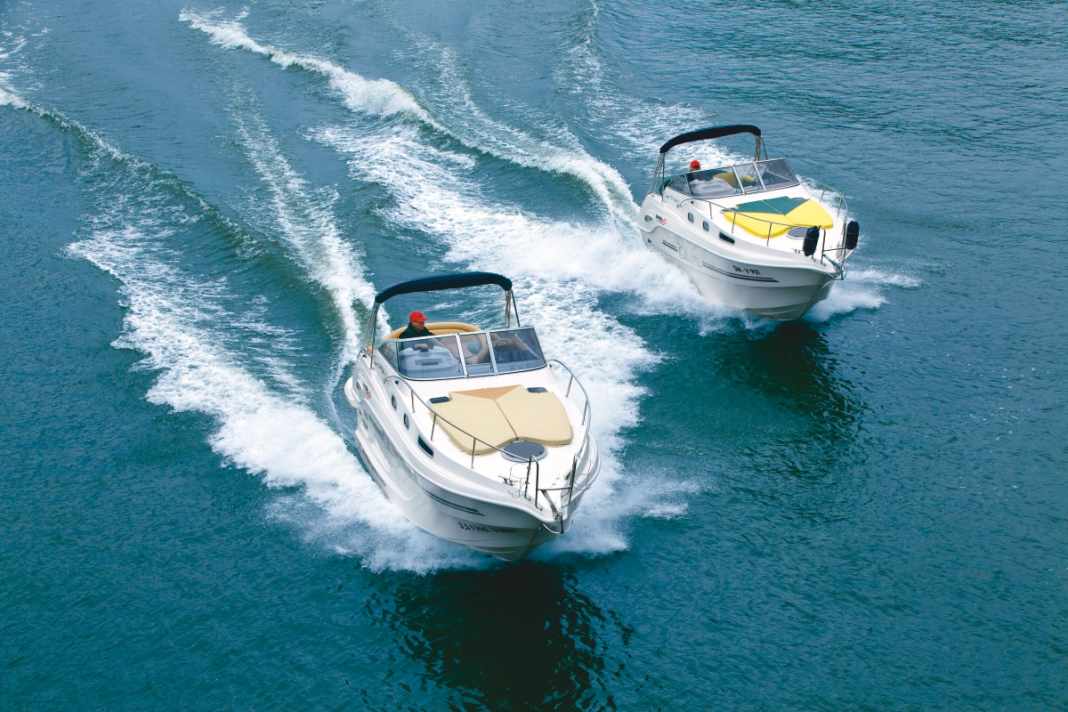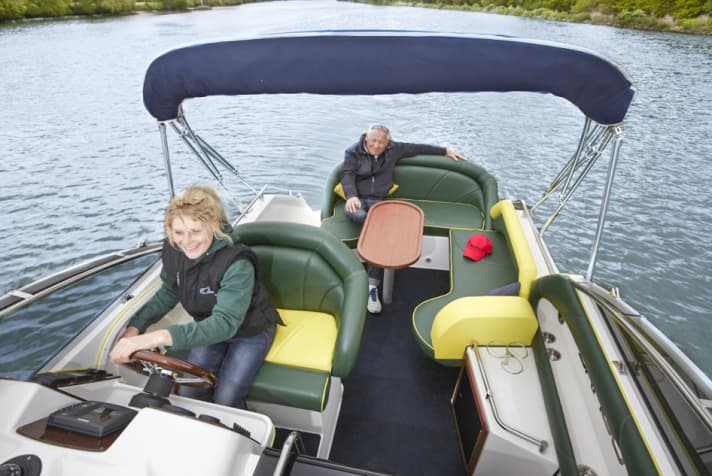





Drago 29 Yachtline Wide Beam and Yachtline 29: Special hull shape versus classic or diesel versus petrol. A somewhat different comparison.
Still trailering a 29-foot boat? With the Drago 29 Yachtline no problem, according to Florian Öchsner from the boat service of the same name. The trick: the hull and deck are manufactured using the so-called "low wood system". This means that as little wood as possible is laminated in, instead Drago uses hollow profiles moulded from GRP for reinforcement. The reward for this construction method is a low weight, which, including the built-in engine, is 2700 kg for a standard boat and is easy to transport with a 3500 kg trailer.
But that's not all. To give the boats better handling characteristics, Senior Dieter Öchsner has developed a special "wide-beam hull" together with the Drago shipyard, which is clearly recognisable by the wide stern.
This means that the hull width is 2.52 metres instead of 2.14 metres as in the standard boat. Disadvantage: During production, you have to work with two hull sections, which makes production more complicated.
Compared to the standard hull, this special version costs an extra 4940 euros. And what does the wide beam do? Due to the greater width, it offers better lateral stability and means that the boat does not dip so far aft. Together with the larger hull area, this guarantees easier planing and ultimately less fuel consumption over the entire planing range.
Test drive with the Drago 29 Yachtline
To emphasise these advantages, we took a normal Drago 29 Yachtline and a Drago 29 Yachtline "Wide Beam" out on the Main. However, the "Wide Beam" is powered by a 220 hp diesel engine and the normal version by a 225 hp petrol engine. Both are built by Volvo Penta.
Apart from the injection system and EVC electronic unit, the petrol engine is pretty old hat, as the engine is made of grey cast iron and has been manufactured and sold by General Motors for decades. It is therefore not surprising that the engine, including the duo drives, weighs 419 kg (dry). In contrast, the diesel engine - which used to be referred to as a heavyweight - weighs only 363 kg together with the drive unit. The reason for this is the modern cast aluminium production.
In other words, our test also means: a modern hull with the latest marine diesel technology versus a conventional underwater hull with a traditional petrol engine.

To ensure that at least the "weight" parameter is identical, the two test candidates have exactly the same test weight of 3470 kg including the FÖ-T35 trailer (also from Öchsner). It should be mentioned here that the "Wide Beam" weighs 90 kg more than the standard version, despite having a lighter engine, due to the full equipment and special owner's wishes. We weighed the latter down with ballast to create a level playing field.
Let's start with the top speed: In this respect, the diesel clearly outperforms the petrol version with 5.2 km/h more. Both engines rev within the permissible speed range. However, at just under 4600 rpm, the petrol engine revs significantly higher than its diesel counterpart at 3950 rpm. Naturally, this is also reflected in the noise level. In figures: 82 dB/A diesel and 84 dB/A petrol engine. This trend continues across the entire gliding range.
In order to better compare the two combinations, we recorded the usual measurement data at 10 km/h, 40 km/h and 50 km/h. The consumption diagram shows that the diesel requires around ⅓ less fuel than its petrol rival at both gliding speeds. At displacement speed, the difference is even more than half.
When measuring the total consumption on the test day for the period of the photo shoot and test drive (about 3 hours in total), the instrument showed 10 l/h for diesel and 13 l/h for petrol. Of course, diesel has a higher energy content (calorific value) than petrol. This difference is around 1.0 kWh/l, but the efficiency of the D3-Volvo is noticeably higher than that of the 4.3-litre V-6 petrol engine.
The costs: diesel vs petrol
However, the unfortunate thing about the diesel engine is that it is considerably more expensive than the petrol engine. Our test candidate costs 16,550 euros. If you then add "Wide Beam" to this, it comes to almost 21,500 euros.
A lot of money that has to be recouped first. If we assume an annual mileage of 50 hours, half of this time at 10 km/h and the other half at 40 km/h, this results in a petrol consumption of around 980 litres. At a price of 1.50 euros per litre (price at the petrol station), this results in expenditure of 1470 euros. For the diesel, 605 litres multiplied by 1.20 euros/litre results in almost 730 euros.
This in turn results in a difference of 1470 euros - 730 euros = 740 euros and, at 21,500 euros / 740 euros, a good 29 years before diesel pays for itself together with "Wide Beam". With an annual mileage of 100 hours, this equates to (only) 14.5 years.
Back to the driving performance and characteristics: When changing from displacement to gliding, you need good acceleration (see table for measured values). The diesel is also ahead in this respect. When accelerating from a standstill, the engine only shows a few "tired" seconds, but when the engine speed reaches the turbo range, the boat accelerates quickly up to the maximum speed without a hitch. Although the petrol engine has a quicker acceleration at first, it loses this advantage with increasing speed when the diesel brings the turbo into play as described.
The anticipation when accelerating is good on the wide-beam version. To achieve the same on the conventional version, you have to use the trim tabs.
Both boats are equipped with a so-called trim assistant, which automatically adjusts the power trim. It worked without any problems on our test boats and both travelled straight ahead without any visual obstructions.
Read also:
In fast bends the Wide Beam also lies on its side, but not quite as vigorously as the normal version. They then pull into the gyro without rocking, before the propellers catch air. The duoprops do this a little earlier in the diesel version than in the petrol version.

At the The conventional hull is a little softer than its wider counterpart when the steering is torn. We cannot objectively assess the rough water behaviour, as we only had sports boat waves at our disposal, which both hulls traverse smoothly and with a stable course. In slow manoeuvres, the test duo behaves similarly directly, both turn almost identical turning circles and at slow speeds you are stable on course.
The seat positions and the ease of use of the rudder and single-lever control are also the same. The engines are easy to reach and there is plenty of space for servicing under the cockpit floor. The maximum engine compartment temperatures were around 30 °C. With an outside air and water temperature of around 18 °C, this is a suitable value.
Below deck, the Duo has a layout with a kitchen block, wet room and double berth forward, as well as an underfloor cabin with two berths and a seating area in the saloon that can be converted into a berth.
Conclusion
The wide-beam version with the diesel engine clearly offers better driving performance than the standard version with the petrol engine. However, you have to pay around 21,500 euros for this advantage, which is not always worthwhile for normal drivers.
This article first appeared on the website in April 2016 and has been updated for this version.

